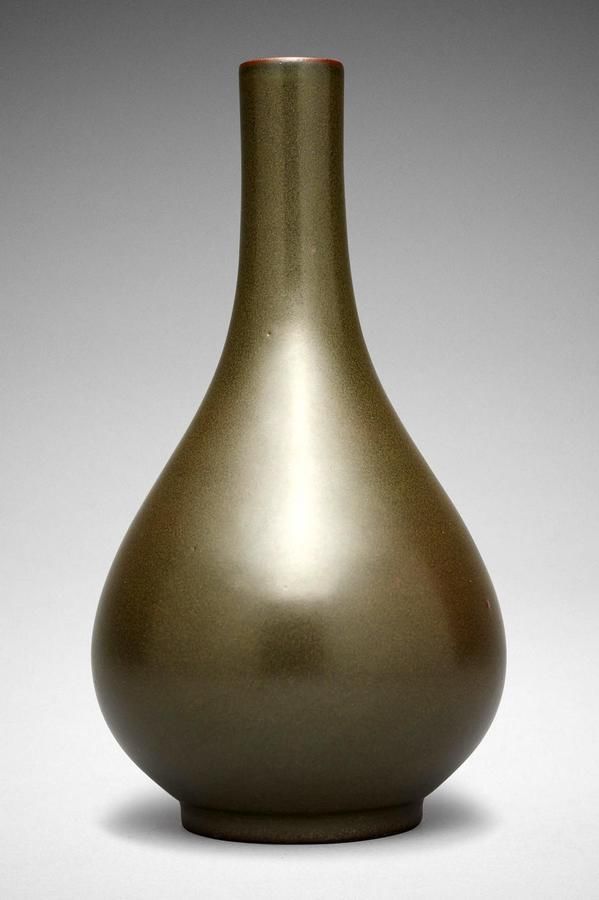
Cosmic Tea Dust Glaze....... Pottery mugs, Pottery cups, Pottery
In Part 2 of this video series we continue demonstrating how to glaze little hand-built wine cups with C-5 Charcoal and PC-63 Cosmic Tea Dust. We love the li.

Qianlong Chinese TeaDust Glaze Vase, 19 cm Ceramics Chinese Oriental
Tea Dust. SW-145. Cone 6 oxidation (larger image): Tea Dust is formulated to produce a rust, semi-gloss glaze mottled with golden flecks. Lighter coats will produce a semi-transparent rust color with little to non-visible gold flecks. Use three plus coats to produce a more prominent mottled effect with the glaze breaking over texture.

Sold Price CHINESE TEADUST GLAZE BOTTLE QIANLONG MARK June 6, 0120 500 PM PDT
Tea dust temmoku glaze. Temmoku ground with mustard crystals. Slower firing and holds create denser crystals. Can be coloured with small percents of cobalt ox. for dark blue and lighter crystals. Original Language: English. Revisions Tenmoku Gold Teadust without Gerstley Borate, tenmoku z fusami PF65 wol10 Si15 Li5 Fe5, Tenmoku Gold (Potash.

Small Bowls, Set of 4 with "Tea Dust" Glaze Functional pottery, Ceramic tea cup, Antique crocks
Cosmic Tea Dust is a sparkly, dark brown glaze, which breaks a light yellow-brown over texture. The sparkle shifts subtly from silver to copper to give the glaze an iridescent quality. Due to the powdered nature of the materials involved with the dry-mix dipping buckets of this product, their respective health information and labels differ from the brushing glazes.

Lot Detail Tea Dust Glazed Hu Vase
Based on previous experience with traditional Chinese tea dust glazes, I created a triaxial based on the original Coleman Tea Dust Black with the intention of increasing crystal coverage. This glaze is a result of gradually increasing silica.

Temmoku Gold Tea Dust Glazy Ceramic glaze recipes, Glazes for pottery, Glaze recipe
The glaze is deliberately under-fired to create the crystal effect. May be safer if fired higher, at which it would become closer to a normal tenmoku. Mechanism. This is an attempt to create a cone 5 oxidation tea dust without a special crystallization firing schedule. Studio firing schedule is a cone 5 with no down firing and.

Tea Dust Glazy in 2020 Speckle glaze, Ceramic pottery, Tea
Tea dust glaze originated in the mid-Tang Dynasty and developed in the late Tang Dynasty. It was named for its fine, tea dust-like flaky crystals. It looks simple but elegant. The dark ones are called "crab shell green" and the light ones are "eel yellow". It is one of the famous glazes in ancient China, "yellow and green, charming but not vulgar."

Cosmic Tea Dust over Obsidian Glazes for pottery, Amaco glazes, Pottery butter dish
Tea-dust. Base and foot rim on a Guangxu mark and period (1875-1908) teadust glazed vase. An olive colored glaze, high-fired green speckled glaze. A 'tea dust' glaze first occurred at kilns in Shaanxi and Henan during the Tang dynasty. Teadust glazes were used on a multitude of pottery even in the Ming dynasty and on provincial wares during the.

Pook & Pook Inc.
This is very expensive. There can be good reasons to use Lithium Carb, but the chemistry in this glaze doesn't seem to need it. One thing it is doing is altering the flux ratio. There are two categories of flux used in glazes, expressed as R2O & RO, and the ratio of these categories is responsible for a few characteristics of the glaze.

Pin page
Learn all about what food safety means, and how to choose and test food safe glazes. Also learn about making pots oven, microwave, dishwasher and freezer safe and more.

Tea Dust Glazed Larger Refuse Jar Taiwan Tea Crafts
Cosmic Tea Dust is a sparkly, dark brown glaze, which breaks a light yellow-brown over texture. The sparkle shifts subtly from silver to copper to give the glaze an iridescent quality. Due to the powdered nature of the materials involved with the dry-mix dipping buckets of this product, their respective health information and labels differ from the brushing glazes.

Cosmic Tea Dust over Deep Sienna Speckle Pottery Slips, Thrown Pottery, Glazes For Pottery
Porcelain, reduction, cone 10. Great glaze in ^10 reduction. Almost a metallic red-brown where too thin, plain black in a medium coat but the little bits of "tea dust" show up where heavy. Can run when too heavy.

Cosmic Tea Dust overlapping Arctic Blue (Angelika Prager) Glazes for pottery, Ceramic glaze
75 of The Top 100 Retailers Can Be Found on eBay. Find Great Deals from the Top Retailers. eBay Is Here For You with Money Back Guarantee and Easy Return. Get Your Tea Today!

Glazy Glaze, Iron, Tea Dust, MC6G 2c Ceramic glaze recipes, Ceramic studio, Ceramic pottery
The silty clay fires to a slightly flowing matte glaze with a yellow-green tea dust color at cone 6 (actual color is more green, less yellow than in these photos). I have not had the clay analyzed but I've made a series of tests by adding various flux materials, frits, silica and kaolin as well as a number opacifiers, and colorants.

8 Pics Tenmoku Glaze Recipe And Description Alqu Blog
The tea-dust glaze on these early ceramics from northern China is characterized by its deep and rich color, which ranges from dark brown to black. The glaze is also known for its glossy and dense texture, which adds to the beauty and elegance of the vessels. The tea-dust glaze on the Yaozhou ceramics is also unique because it is created using.

Antiques Atlas A Perfect Ruskin Tea Dust Green Lustre Glaze Vase
The glaze preparation is quite interesting. The ingredients (excluding the white clay (白土)) is ball milled for 30 hours, then white clay is added and the full glaze is milled for another four hours. After adding water, the glaze is sprayed approximately 1mm thick. Firing is to 1250°C in a weak reduction atmosphere.